#CHRONOLOGICAL META.
Explore tagged Tumblr posts
Text
[/league/lazarus] ENTRY 001.

DAY 004, 16:12Z. west of nanda parbat. the league of assassins is a centuries old myth made flesh: a group of half-maddened shadows that all follow a single timeless man with the goal of molding the world into his image. they work as a uniform body, each a muscle under the scrutiny of the head of the demon. few ghouls leave the side of their master, for who would forsake such intoxicating power to live among mortals again? to have the demon's favor is to be afforded the life-giving powers of the lazarus pits.
from the breast of the source came the seven forces of the universe, with life force & death force being the most important in their relation to the league. the death force is a primordial energy which is intangible to mortal & immortal alike -- though exceptional mortals have briefly harnessed it with disastrous results, such as the possession of the tear of extinction by the late king arion of atlantis.
those who live through brushes with the death force are said to have become corrupt, necrotic bastardizations of their former selves; this sacrifice of sanity also affords the entity with an infectious affinity to take the life force of others. in contrast, life force affords organic matter to flourish in the multiverse; entities that interface directly with the life force are said to retain a connection to all life & are afforded the power to compel & control any life born of the sea. the only known entity to have directly interfaced with pure life force is the greek deity poseidon.
power struggles between pantheons after the source birthed them all caused untold catastrophe across earth as each laid their claims to the planet. these disasters formed great mountains & perilous valleys, within which concentrated pools began to form where the blood of gods were spilled. as eons passed, undisturbed life force & death force mingled into a physical manifestation best described as an unnatural syrup-like liquid that emits an eerie emerald light despite a lack of bio-luminescence.
to the rest of the world, the earthen hollows that contain the lazarus resin are most commonly referred to as ley lines.
these pits, as they would eventually be coined, remained undiscovered by mortal life until 688 CE when a young healer discovered the first in the arabian peninsula on the search for the cure to an unknown ailment that plagued his patient. in a desperate attempt to save the man as the spirit of ahriman watched nearby, this doctor & his wife placed his patient into the pit. the perfect balance of life & death cleansed his body of the disease; the toll paid in return was the clarity of his mind. maddened by the invasion of the connection to all existing life & the rot of necrosis, he strangled the doctor's wife before the effects had time to wear off.
the doctor razed the city of qaryat al-faw in his grief & set out to discover more about these mysterious pits. well rounded in the mythos of his era, the doctor named this phenomenon a lazarus pit. having witnessed the first man to be resurrected in the likeness of lazarus, the doctor was cautious in his experimentation & it took many years before he began to harness its strength to preserve his youth & that of those who followed him. those who pledged themselves to his cause were blessed by their leader to access the pool in healing major injuries & protect them from the sands of time. first among these were the doctor's parents & the badawī tribesmen whom he had been raised among.
rā's al ghūl, my grandfather, achieved complete control over all discovered lazarus pits in the world; he discovered almost all himself. through these, he maintains near immortality & has returned from death hundreds of times. as of this written account, rā's al ghūl is deceased.
he will return; i will understand who he once was before that day comes.
#⊰ ℜ ⊱ ┊ i need not for your absolution; do not hold that sword over me. ┊ DAMIAN WAYNE: CANON.#CHRONOLOGICAL META.#rattles the cobwebs out of my brains#behold: i officially took a stance on the pits
9 notes
·
View notes
Text
on nagito komaeda and love
I just think it’s sort of funny that for a character whose (arguably) most well-recognized CG is this:

komaeda’s narrative so heavily centers love. and I don’t just say this because I’ve had komahina brainrot for years (though this is true!!). even if you don’t care about komahina, it’s tough to deny komaeda is a walking tragedy in large part because of the role that love plays in his life. his characterization is driven by the way his luck has denied him love, and how he seeks it out regardless. in that sense, I think that without understanding komahina as at least one-sided, you miss out on one of the juiciest, most miserable pieces of komaeda’s character development.
tldr; a love-centered reading of komaeda makes sense, recognizing komahina as “a thing” in DR2 (whether you ship it or not) is pretty important to understanding how komaeda operates, and I’ll try to prove it right here under this page break!!
Part 1: Komaeda’s Love Life (or, his life without love)
I think it’s safe to assume that if you clicked here, you know about komaeda’s absurdly miserable, tumultuous childhood, but I’ll do a quick recap just in case! meteor kills his parents on a plane, he inherits a ton of money. he’s kidnapped by a serial killer, he finds a winning lottery ticket in the garbage bag he’s thrown out in. he’s diagnosed with terminal cancer and dementia, he gets into hope’s peak.
in his free time events, komaeda *explicitly* frames his luck cycle as something that takes away the people he loves. it only “takes action” against him after his relatives have died (for the sake of this essay, let’s assume that komaeda loved his parents, or would have at least been hurt by their passing). by way of other close connections… well, his wording here implies that by the time of his diagnosis, he didn’t really have anybody in his life.

either komaeda didn’t allow himself to get close to anyone after the meteor incident, or he did, and they were taken away by his luck. at some point during his childhood, komaeda learned he should view himself as a death sentence.
so, how does this loss of love shape the komaeda we know? I’ll talk about this in terms of four of his defining (and connected!) traits in DR2 canon – the ones that really make his actions make sense: his self-loathing, his hope-seeking, his learned helplessness, and his certainty that his existence poses a threat to those around him. komaeda’s experience with loss makes him view himself as a source of death, which in turn fuels these tenets of his character. ultimately, his loss and the complexes that arise from it give him good incentive to push people away.
his self-loathing
komaeda hates himself. he views himself as worthless outside of his potential to serve as a “stepping stone” for the hope of the ultimates. he claims that this is driven by his beliefs around talent, which are in turn linked to the way his worldview rests on viewing hope as “absolute good.” the talentless (himself included) are only good for advancing the hope of the talented. still, his self-loathing is a bit more personal than that. take what he says and dig just below the surface, and it’s a clean cut trauma response all the way down. which leads us directly to…
his hope-seeking
komaeda is willing to do literally anything to serve hope. on the island, this (in short) means dying. this is where I prod at komaeda’s reasoning a bit more: komaeda’s willingness to act the way he does in canon also stems from his belief that his dying would be a net good for the world. his existence kills the people around him. his illness will kill him anyway. he has less than no value, and hope is invaluable. to go out for the sake of hope would give his wretched life purpose; it’s his dream come true.
and it’s no mystery why komaeda cares so much about hope: again, it’s a coping mechanism! komaeda’s belief that all bad luck is a necessary precursor for good luck and that hope will always triumph over despair is (as he himself says!) the only reason he’s managed to stay alive. I’ll say it again because I really can’t emphasize it enough – komaeda thinks that just by existing, he kills the people he loves. ouch!
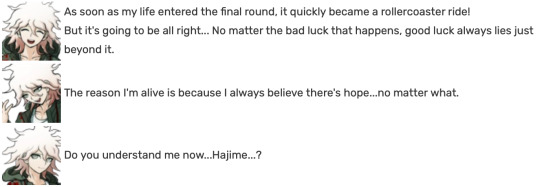
learned helplessness / his existence as a threat
komaeda has, essentially, learned to submit to his luck cycle. all bad luck is good luck in the end – isn’t that amazing?! almost paradoxically, he’s hyper-vigilant about the negative impact his luck has on those around him. this is a tricky one. I make sense of it this way: komaeda’s perception of how much his luck impacts the people close to him isn’t inflated, like, at all. the supernatural way the world bends around komaeda to screw him over really does pose a danger to himself and others, and he takes measures to minimize that danger. his stated acceptance of his luck cycle is… well, again, he’s coping.

if komaeda really thought that all bad luck is ultimately good luck, he wouldn’t try to protect his classmates from his bad luck. but, as we see in island mode, he does!

but really, who could blame komaeda for lying to himself? I’ll restate the facts. komaeda thinks that luck is absolute power. he says that he’s powerless against it. his luck has taken his family, and it’s left him with nothing but money that he doesn’t want. he’s certain he’s a curse, and there’s no end to that in sight: so long as komaeda exists, he’ll keep on losing – murdering – everything he loves.

in the face of all of that despair, what can you do but abandon your self-esteem and pray for something good to come out of all of it? how else could somebody possibly survive carrying that burden, truly believing that load will never be lightened?
tldr; komaeda thinks his existence is a threat, and a big chunk of his personality is a frankensteined way of surviving the pain that comes with that. still, we should question how much of his worldview komaeda has really internalized without inner conflict.
Part 2: Enter Hajime Hinata
we get some answers on that front when we see that despite the clear and obvious danger it poses, nagito komaeda still finds himself falling hard for hajime hinata. that’s really, really loud.
I’ll preface this part by saying that you don’t need to actively ship komahina to understand what I’m trying to get at here. this said, I’ll be recapping an argument you’ve almost definitely seen before: komahina is definitely “a thing” – at the very least as a one-sided thing. to this, I’ll add the (perhaps bold?) claim that without recognizing that much as true, you’re missing out on a big part of what makes komaeda so interesting.
komaeda’s FTEs make it abundantly clear that komaeda has feelings for hinata. apart from his famed failed love confession, the fact that komaeda is willing to allow hinata to get close enough to learn about his views on hope and luck is telling.
(the smoking gun here hinges on trusting that komaeda was telling the truth during the time you spent with him; in so many words, that he only lied about lying. so, for the sake of argument, let’s assume this is true! there’s good proof for it, anyway.)
if you read his final FTE as komaeda flashing his soul to hinata and making a decision at the very last second to retreat, turning to old coping mechanisms to protect hinata from his luck, it’s sort of a komahina bombshell. that capitulation spells out for us that komaeda understands sharing his life experiences with hinata to be one of the most intimate things he could possibly do.
he recognizes the exact moment he lets hinata get too close – when his life story is finally told – and he does what he’s learned he needs to do to get them both out of that situation safely: he tries to make hinata hate him, and tells himself (and hinata!) that he did it for the sake of hope.

(and yet, komaeda let hinata approach him every FTE, knowing damn well that they were both playing with fire… very interesting.)
now, let’s say you don’t consider the FTEs to be integral to canon. I mean, you can really easily miss out on all of komaeda’s content if you choose not to hang out with him in chapter 1! so, for the skeptic, in the unskippable main story, komaeda tells hinata this:
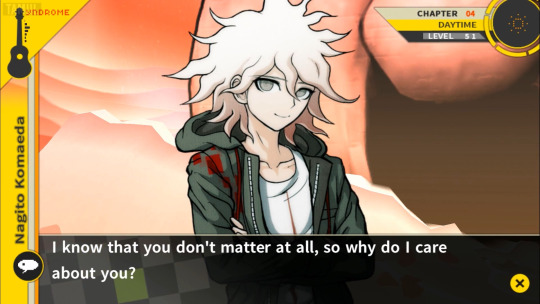
komaeda cares about hinata despite everything. and I really, truly mean despite everything. at this point in the story, the fact that he still cares about hinata calls into question basically every single one of his core beliefs. he’s read his final dead room prize – not only does hinata not have a talent, we can presume that komaeda also knows hinata became ultimate despair along with the rest of them.
hinata has continually sought out komaeda’s company, even though komaeda knows himself to be worthless at best, lethal at worst. komaeda was willing to let him get closer, even though he knows how dangerous that is for hinata. he can’t help but let hinata try to know him.
isn’t he awful? to want what he knows he can’t have, even though that wanting has never done anything but cause pain? he’s really the lowest of the low, to love someone who destroyed the world, who makes him question the views that will allow him to do the only good thing he’s ever been able to do for it: to die for hope.
and yet, it’s a nod to how incredibly capable of love komaeda is that he’s still willing to reach out for it, no matter how many times it’s burned him in the past, and how much it hurts him in the present to want it. he understands more than anyone that his feelings can only result in disaster. reading komaeda as someone who can’t help but go on loving anyway makes his story hurt so much worse.
but, you miss a whole lot of that without an eye for komahina. seeing hinata as the eye of komaeda’s emotional hurricane (and keeping tabs on their connection accordingly) allows us to glimpse past the cracks in komaeda’s front. we see that komaeda’s worldview is less stable than he presents it as – hinata is where komaeda’s coping mechanisms, for better or worse, run up against a wall. that tends to be uncomfortable for a guy who’s just barely coping in the first place. then again, growth is supposed to be uncomfortable, isn’t it?
Part 3: The Future He Chooses
so, all of this considered, I think one of the most interesting ways you can flesh komaeda out post-canon is by asking how he’d find himself willing to accept love. whether that love is from hinata or the ultimates, whether it’s platonic or romantic, love is the thing that komaeda wants AND fears in equal measure more than anything. it’s the source of his self-loathing and his obsession with hope. it’s the reason he’s lived the way that he has for so long – lonely, and afraid of being anything but.
getting into a relationship wouldn’t solve komaeda’s problems for him, and that’s a good thing. it would force him to confront old ones, and probably create dozens of new issues for him, too. writing him through that makes for great character study!
hinata (or anyone else, for that matter) can’t love komaeda into loving himself, but he can give him a shoulder to cry on while he works through 22 years of fear and sorts through the wreckage of a worldview that’s long since stopped serving him. I don’t think his progress would be linear. but, I think that he could do it. komaeda learning to accept care is what his healing looks like.
(well. and physically recovering from cancer and dementia. but that’s neither here nor there!)
a post-canon komaeda learning to love narrative is also in line with the themes of DR2. hinata leads the survivors out of the neo world program because he makes the decision to choose his own future, creating a new version of “hope” for himself and his classmates. likewise, komaeda can make the decision to save himself. that is, if he trusts himself enough to actually touch and hold the thing that he’s never been able to stop reaching out for, anyway.
after all, hinata is lucky too. (and if it turns out he isn’t… y'all like angst fics, right?)
(shoutout to @cynopter for looking this over and confirming that I'm not spouting nonsense <33 thank you for reading my thesis of the week <33)
#ngl I'm a *teensy* bit nervous posting komaeda meta on here because you komaedologists really know your stuff!#if someone's done this already 1) oops and 2) I really hope I contributed to the existing convo at least a little#this essay was inspired by my friend's 3.5 hour long plot-heavy nagito playlist (chronological birth to death)#which I listened to in its entirety on a bus ride the other day#got me thinking wow. after everything. how on earth is he still capable of love? that's incredible. that's painful. fucking hell.#also if you read all of this I adore you! because what the hell I got so carried away#komahina#nagito komaeda#hajime hinata#danganronpa 2
151 notes
·
View notes
Text
something about learning, idk



#no i will not elaborate#/hj anyway#kirbyposting#my art or something#meta knight#kirby#sailor dee#bandana waddle dee#metadad#quinn does comics#this is in chronological order. it counts#yesterday was Father’s Day and i did not think to post this ???
176 notes
·
View notes
Text
5 Good Omens Timefucks that Haunt Me
1.
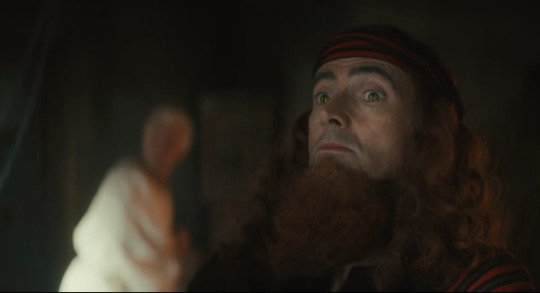
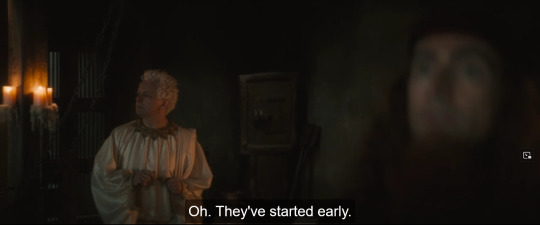
Why is this here? Why is this line included? Is it just to add texture, to imply that larger world of corporate fascism of which Crowley and Aziraphale are subjects and victims and little worker bees? If so, why "They've started early" specifically? Why not "I wouldn't have expected that shrub to be the first to go" or "Aw, I liked that rock formation"?
Crawly doesn't make this comment in an offhand way: he sounds a bit taken aback and not thrilled that things have kicked off sooner than he anticipated. But it doesn't ultimately seem to make any difference to this scene, so why do we, the audience, need to know Hell started early?
2.


This one I'm not as confident will turn out to be significant, because iirc it appears in the book, which was a complete story when written, and because it serves a narrative purpose: it puts Agnes Nutter in charge of the situation, not her murderers. By backfooting Witchfinder Major Pulsifer, Agnes startles him enough she's able to walk past him without Pulsifer seizing her and discovering the extra 80 lbs of gunpowder and roofing nails in her skirts.
But. Agnes Nutter's sense of time is Nice and Accurate, and she notices the witchburning party are late and remarks on it to herself before she says anything to Pulsifer. So assuming a few minutes to position Agnes, tie her to the stake, and read the charges and conviction against her, Pulsifer and Agnes' neighbors are 12-15 minutes later than they should be. Why?
If the book answers this question, I don't recall; the show does not. And again, it seems to make no ultimate difference to this scene.
I'm not saying this was even purposely included in S1 as a timefuck. I am suggesting that as Gaiman seems to be fucking with time or timelines in this story, even if he and Pratchett didn't plan it like this when discussing the sequel, a retcon is hardly out of the question.
3.
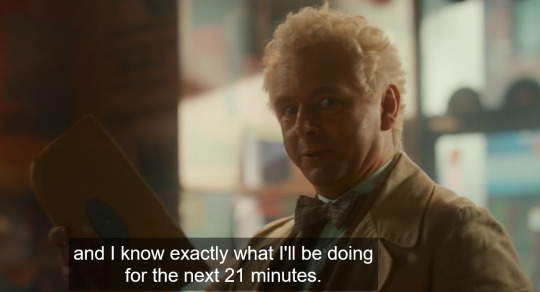
As others have pointed out, Shostakovich's Symphony No. 5 is 45-55 minutes long. If you're listening to it on 78s instead of LPs because you are a CRAZY PERSON, it's going to take you more like 1 hour 5 minutes, because one side of a 78 holds, at most, 5 minutes of music, so every 5 minutes you have to get up and flip or switch the record.
Shostakovich wrote his 5th symphony in response to criticism in the state newspaper (possibly penned by Stalin himself) that his previous work didn't suck the Communist Party's dick hard enough--the kind of criticism that put him in danger of being sent to prison or killed. At the time it was first performed in 1937, Symphony No. 5 was considered a massive triumph, walking the line perfectly between Shostakovich's artistic standards and the Communist Party's demands of him.
The choice is symbolically significant, but it's a symphony, so whoever's censoring it isn't censoring lyrics or information. Again, why? Why is a 45-55-minute symphony only 21 minutes long? What did the time thief do with the 24-34 minutes?
4.
Here's the rug that covers the portal to Heaven in Episode 1:

Here's the rug in Ep. 2:
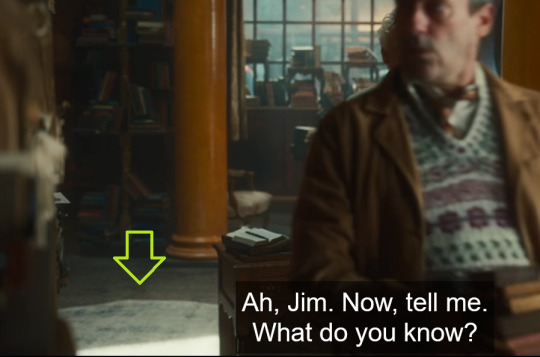
Aziraphale does not change this rug for the party. We know this bc we see it in Episode 5 when Mrs Sandwich enters the bookshop and the party is in full swing:

Now here's Aziraphale moving the circular rug to expose the portal to Heaven:
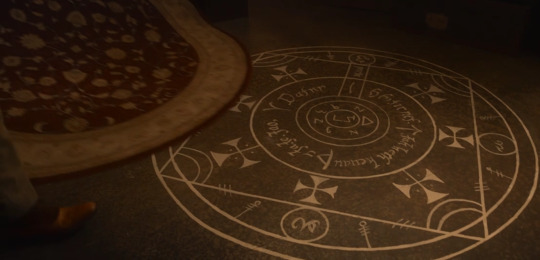
But here's Crowley, putting the rug back:

Why are there two different rugs?
5.
Every end credits track has the first line of "Everyday" embedded in it But after the line from "Everyday," at the end of Episode 4, the theme skips twice like a vinyl record, and then is stopped by whoever controls the turntable and restarted, with several seconds of music having been skipped over.
This is not the first time it has mattered to a character in Good Omens what we in the audience see and hear. I argue here that God asks Aziraphale what he did with the flaming sword She gave him in order to show us the audience who Aziraphale is. God also addresses us the audience directly in S1, not only narrating about characters omnisciently but speaking to us about Herself in first person.
Now we evidently have a second character who has gone meta and is changing what we the audience experience of this story, and--indications are good--the story itself.
#good omens#good omens s2#good omens meta#good omens timefucks#good omens chronology#good omens discontinuity#good omens as metafiction
665 notes
·
View notes
Note
Alright I know the gag of people asking for spoilers has been run into the ground by this point but I think it’s still funny so here goes:
Hey can you describe the upcoming plot in very specific detail? Actually maybe you could draw it so it’s easier to follow the action. Although drawing and writing all of that at once might be a lot to handle, so you could release it in batches every once in a while instead of all at once. It would be like some sort of webcomic! Then we could read the updates and learn the plot as we get new pages! What a neat concept, am I right?
idk man, that seems like a great concept, but I'm afraid it's a bit far-fetched.
Do you really think anyone would read that? Like, pay attention to the dialogue and understand what the characters are saying? Figure out small bits of foreshadowing in order to theorize effectively about what could happen next? Consider larger themes and put them together with how the characters act to understand the author's intended meaning beyond just the surface-level, at-face-value reading and shallow interpretation of only what is immediately apparent on the page?
It feels like it could be something... but I just don't know.
#comics tell stories: big if true#things that will happen in the comic will be revealed through chronologically logical events presented by the author!#chekhov answers#meta#thank you for the laugh#this is good
328 notes
·
View notes
Note
I’ve been rereading some of your Fallout posts lately and something in particular caught my eye. In a post from October 2023 you said that Fallout 1 and 2’s timeframe didn’t really work for the vibe they were going for, especially with regards to Arroyo. Is there any chance you could elaborate a bit on that? I’m interested to know where in the timeline you think the games might fit better.
My thinking at the time that I wrote that post-and, to some extent, my thinking to this day- is that Arroyo and The Brotherhood of Steel are depicting a level of cultural change and mutation that doesn't necessarily align with the time frame on which they're claiming it happened. What's depicted isn't strictly impossible, but the specific aesthetics they're using are usually used to indicate way more time has passed.
With the Brotherhood, the primary referent for their regression to neomedieval monasticism is A Canticle For Leibowitz, a novel from the 50s about a post nuclear monastery that's dedicated, half-successfully, to preserving technical and cultural knowledge in the new dark age; the book opens when they've been at this for about 600 years, with the attendant levels of ritualization, information decay, and historical misinformation about the old world that would imply. Fallout frames the Brotherhood as having ended up in a similar spot, structurally and culturally, after only 80 years, and under the leadership of the grandson of the guy who started the thing. It's not impossible, you can make it work, but ultimately they're using aesthetics that gesture at it having been a longer time.
Arroyo is the other big example of this; 80 years after fallout 1, they've developed a "tribal culture," complete with ancient traditions and mythologization of historical events, despite the fact that the whole settlement was founded within living memory by a person who isn't even confirmed to be dead when the game starts. It's only been three generations! Tandi is still alive and running the NCR! This one's even more egregious than the brotherhood, given the existence of that gigantic fuck-off stonework temple complex ripped out of Indiana Jones. Where did that come from?
Some of this might be is that the nature of 90s graphics prevents you from seeing what Arroyo culture looks like "on the ground" in higher fidelity , which would make the cultural continuity between "exiled vault 13 dwellers" and "sustenance farmers" more obvious. Part of it is that my understanding is that Fallout 2 had a much more disjointed production than Fallout 1, so it's possible different teams were operating under different ideas about the chronology at play. And some of it is that Fallout 2 is a game that, to it's frequent detriment, leaned way harder into 90s pop culture wackiness and, to be blunt, outright racial caricature, than Fallout 1 did. It's possible that having the descendants of Vault dwellers re-organized as a stereotypical "tribe" as envisioned in 50s pulp sci fi is just an extension of the same unfortunate impulse that resulted in the game's depiction of San Francisco as Kung Fu Movie Town-The franchise's use of "Tribal" as a category is already pretty fraught in ways I'm not the best equipped to tackle, but Arroyo's depiction might be wrapped up in that.
Either way, thematically Arroyo functions fine- it creates a fish-out-of-water from an isolated agrarian community who goes on a hero's journey that ultimately brings them into conflict with their aesthetic opposites- a mob of deranged, Americana-draped technofascists. Holds together perfectly well on that level- just don't look at the numbers too closely...
#the great khans in new vegas are also subject to this#their writing banks heavy on them being pattern-matched to Native Americans being squeezed out by manifest destiny#but if you sit down and work out the actual chronology they can only really have existed in their current iteration for about 35-40 years#thoughts#meta#fallout#fallout 1#fallout 2
41 notes
·
View notes
Text
so all of the fic where the GAR and Coruscant Guard don't get along because the GAR thinks Coruscant is a cushy gig and the Guard are in Literal Hell are
so fucking chefkiss
like it is a trope i will DEVOUR, i will unhinge my jaw and swallow that shit whole
but
what about an inverse?
what about a Guard that's the protecting soldier meme except real?
troopers on leave on Coruscant finally feel like they can relax from the war because they know the Guard has their back, and everyone knows that if you need a hand or an ear or a hug you can ask any Guard* and they are always the most patient helpful big brother types ever, they will listen and they will help and they will protecc
(*sole exception: fox**, who shoulders all of the pain and rage and condenses it into a tiny supernova of fury in his chest that he shoves down into a locked box of emotions, and one day he'll die
**except also very much including fox, who rages and rails and might throttle you for being an idiot but he'll also absolutely gut any aggressive natborn that even breathes in your direction)
so they still might think that Coruscant's a cakewalk compared to the frontlines but they're glad that they have brothers protecting the homefront too, they're glad that at least SOME of them can stay gentle and kind and at peace
of course then palpatine and the sith and all the corruption in the senate are exposed
(because TCW canon is for COWARDS and people who like being SAD)
and the GAR realizes all the shit that the Corries went through, all the ostracization and threats and abuse and pain
and it just
made them kind
#tcw#tcw meta#coruscant guard#commander fox#things i need to know:#is 'natborn' canon or fanon#and is calling the guard 'corries' canon or fanon#no i haven't finished watching the series yet#it is a STRUGGLE okay#tho i have switched to watching it chronologically#which makes the experience like 45% less infuriating#maybe 35%#the next in the list is a jar jar episode and i've been putting it off for a week#liz's tcw watch order: depends on how much i want to grind my teeth that day#but i did get to see baby domino squad and that was gr8#99 deserves better 2k23#someone else should write that
442 notes
·
View notes
Text
The Lannisters + Cunning

A Game of Thrones - Tyrion III

A Game of Thrones - Tyrion IV

A Game of Thrones - Tyrion V

A Clash of Kings - Tyrion I

A Storm of Swords - Tyrion I

A Storm of Swords - Tyrion III

A Storm of Swords - Tyrion VI

A Storm of Swords - Tyrion VI

A Storm of Swords - Tyrion VIII

A Feast for Crows - Cersei III

A Feast for Crows - Cersei III

A Feast for Crows - Cersei V
#house lannister#tywin lannister#tyrion lannister#cersei lannister#meta#valyrianscrolls#hmm. lots to think about#i love how this word is interchangeable to them re: positive and negative#they use it as a compliment and an insult#I debated if I should keep the one about their father or make the post just about the two siblings#but i think it is meaningful that he is also described that way#btw this is in chronological order of quotes#mine#reference
44 notes
·
View notes
Text
my pretentious trait is that i get richard ii and coriolanus, RIP to the haters but they're literally the two best plays in their respective categories because the leads are That Good in my opinion
#critics: who even are these people#me: gay obviously#no but imo they're two of the characters that speak the most truth in shakespeare#id say hamlet gets some of that as well (but im still warming to that one bit by bit) and julius caesar#and usually there's a scene in aaalmost any shakespeare play in which one or more of the female characters spit truth#(and then it's just about whether they're respected and/or believed in that truth-telling)#but these two. margaret is also underrated imo but i imagine thats because she's stuck in the middle of henry vi#but yeah i think coriolanus and richard ii wear their hearts on their sleeves and idk. it seems to alienate for some reason#shakespeare#coriolanus#richard ii#richard ii literally spelling out the whole Theme of every play that chronologically comes next *let's speak of graves*#and for her to be Disrespected like this?#i once did you common cry of curs over and over for the satisfaction. after All That!!!#the Poetry of these plays!!!!!!!!!! the meta thematic throughlines of them!!!!!!!! the Scale of them!!!!!!!!!!!!
26 notes
·
View notes
Text
heads up, gaypiratedivorce over on ao3 put together a full canon timeline for iwtv - link here - which has been a fantastic resource for writing fic.
unfortunately, it has also shown me i'm a dumb dumb and got grace's age wildly wrong, which is not a big thing overall except that the fic i'm writing was built on my incorrect assumption and i'm 12k in. so i guessed she was like, twenty-five-ish at her wedding?? anyway i came to this conclusion from the age of her actress (thirty at time of filming), paul and louis' given ages (thirty and thirty-three in 1910/11) and morgan's comment in 2x01 about her being 'about sixty now' in a thirty-five year old photo from her wedding in 1944 -- but no. going by the comment that louis missed her thirtieth birthday during florence's 1923 wake, she was likely about EIGHTEEN in 1911.
why, i hear you cry, is this a big deal to me? bc it means that levi proposed, at the absolute oldest, to SEVENTEEN YEAR OLD and that's why he didn't ask florence's permission to propose. he's not only useless and an asshole, he's also creepy as hell!! and Paul Was So Right for all of this:

truly. what the fuck levi. louis should've fucking eaten you
#yes im aware that lestat and louis' age difference is like over a century. shhhh. thats not the topic of discussion rn#iwtv#meta#kinda??#grace de pointe du lac#levi freniere#paul de pointe du lac#louis de pointe du lac#anyway use the chronological timeline its fantastic. if anyone knows the author's tumblr lmk and i'll tag them here
22 notes
·
View notes
Text
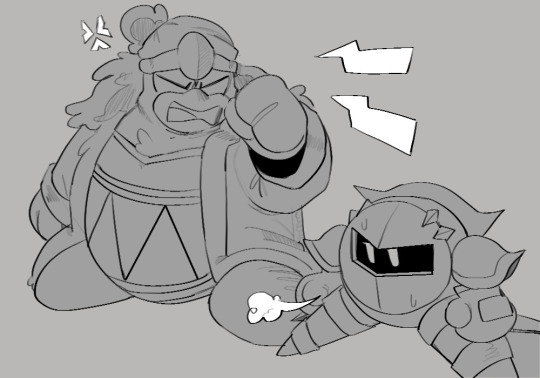
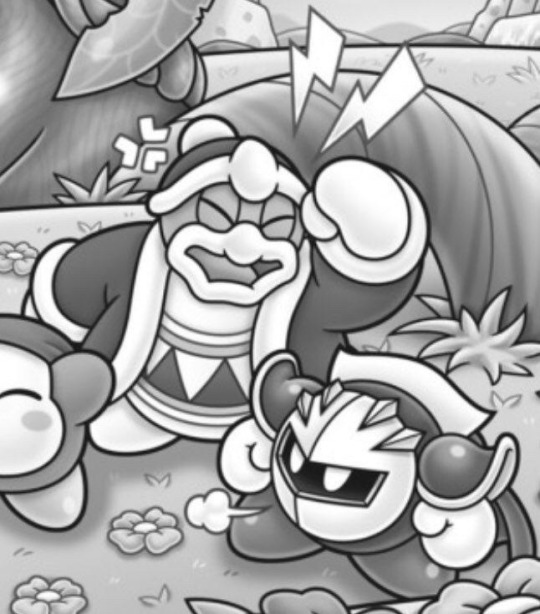
Redrew this illustration from the novels
#kirby#kots#kirby of the stars#kirby fanart#hoshi no kirby#dedede#king dedede#meta knight#i just find their dynamic in the novels extremely charming#it started with Dedede thinking he's besties with Meta Knight or something and Meta being fed up with him#and ended with Meta Knight enjoying his time with Dedede so much specifically because he likes to piss him off#meta knight enjoys seeing dedede being a dumbass so much it fills his heart with joy#and mine#if you read the novels chronologically you can actually tell Meta Knight starts being happier by the last ones and I love that#he's just giggling and laughing and king dedede is confused and wants to be offended but also proud#i also love how their dynamic changed around the middle#right around the strongest warrior in the galaxy#everyone was like 'noo Meta Knight wouldn't do this he has to be possessed' and Dedede is 'he would totally do this'#and then he's proving right by the end i love that for him#dedede knows meta knight better than anyone and he knows that man is an ASSHOLE /pos#i loved their dynamic in the rtdl novel a lot too truly the adhd vs autism of all time
237 notes
·
View notes
Note
I’ve been thinking about what you said in regard to Johannes becoming a ghoul, and now I’m wondering what it means that he felt such a strong camaraderie with the ghouls. I feel like there’s something I haven’t figured out yet as to why his friends are ghouls in particular, but I like the idea that Johannes is more open to making genuine connections (and not shunning those feelings) while he is animalistic
personally, i think it boils down to how he's never (felt he has) been treated with compassion, empathy, and understanding by any of his fellow human beings, except for his deceased love. my interpretation of why he felt companionship with the Other and the Animal is heavily based on, just. how insanely autistic coded Johannes is.
he's strange, he's weird, he doesn't get social cues right and his interests aren't normal ones. he didn't feel loved by his family, was almost definitely socially bullied & peer pressured by his brother throughout their childhood if Johannes' outright hostility towards Horst & remembering specific events where he humiliated him in book 1 is anything to go by, and as an adult is constantly called a psychopath and not human to his face (thanks for that, Leonie. really showing off the psychology part of your criminal psychology degree).
Johannes was never treated as a human. yeah, sure, dabbling in the dark arts of necromancy and going against every social "normality" there ever was will do that, but he wasn't treated as one to begin with, either. at some point he likely internalized that, and being forced into the shape of a ghoul simply externalized that ever-present internal fear. he simply realized halfway through that he still liked some parts of humanity, unlike all the other ghouls who, if not enthusiastically, fell into the maladaptive coping mechanism of embracing their inhuman status.
which is to say that the reason Johannes made more connections as a ghoul than he did as a person is the same one that causes many neurodivergent & socially undesirable people in real life find comfort in the animal and bestial:
reject the pain of personhood. become a dog instead.
#korro.response#surfinthehighway#johannes cabal#johannes cabal meta#the fear institute#it is worth saying that the first person* (chronologically) he finds a genuine connection with is also an absolute freak#but i don't know if you're been introduced to her yet as she's a short story/book 5 character#but keep it in mind: johannes becomes more willing to engage with human sociability#the moment he feels comfortable that he will not be othered and mocked for not being good enough at being a person
15 notes
·
View notes
Text
Uncomfortable Ramifications
As a separate follow-up to my post about my perceived disparity between the actions and their results of the alarms in heaven and the apology dance, I'm going to try to describe - as if it isn't obvious - why these are so scary to try and resolve. And this is coming from someone who is all-but onboard with the possibility that there are two realities (for want of a better word). And/or that things are so very out of order. Or overlapping...or something!
So, yeh, I'm just going to put myself out here for ridicule and pity. But I think I will feel better just to get it out of my brain and out there.
If we I try to put the bright flash of light in heaven with the Jim-hiding miracle, that puts Crowley in two places at the "same" time... but at two supposed different chronological times (????): performing the miracle with Azi AND being in heaven with Muriel and Saraqael, which is supposed to be during the demon attack. WTH?
In my post comparing the different Arrivals, I asked about this:
As for those trumpets...what? Why are we hearing trumpets? I know we hear them in S1E4 after they beat up Aziraphale and that was to signal that Armageddon was starting.
If the trumpets that Azi hears in the music shop with Maggie in E2, are when Crowley and the angels return to earth as a result of Azi blowing up his halo and nearly declaring war on hell, rather than the "hiding Gabriel" inquiry...well, that obviously puts Azi in two places at the same...different...time. WTF?
As an aside, if the trumpets really correspond to Michael, Uriel, and Saraqael simply going to earth, to the bookshop, to inquire about Gabriel, that seems to contradict the Metatron's desire (order?) to explicitly NOT raise any alarms about Gabriel's disappearance.
SARAQUEL: Right. I can't… I can't find his memory anywhere. In fact, I can't find him in the building. He's left Heaven. Should I sound an alert? METATRON: Oh, don't be so wet. No, you're all just going to have to find him. That's all.
So, again, I ask, what's with the trumpets?
Anyway, I don't even know what I'm saying anymore.
If the apology dance is for not returning to help defend the shop against the demons, that puts the demon attack before they even perform the miracle to hide Gabriel. Not to mention before the kiss and Azi's departure.
So even though the actions (e.g., the hiding miracle/halo explosion, and what warrants an apology dance) and their results feel out of proportion, trying to swap those around just makes things worse.
And, yes, I am very much aware what utter BS this must sound like. I get it.
My own brain hurts. It's just that I'm having a problem taking the chrono order that we've been shown without questioning it. On the other hand, perhaps I have no choice.
I hope I have given you all a good laugh. And maybe this post just needs to sink into obscurity. Yeh, probably for the best.
#good omens s2#good omens trumpets#good omens chronological order#good omens realities#gos2#good omens questions#good omens stupid theory#embarrassing myself#go meta#good omens meta
11 notes
·
View notes
Text
Mr. Pilot dropped a brick of lore on us out of nowhere. sir, i was not quite prepared,
this has been sitting in my drafts for like a week bc i was planning to finish the Sapphire transcript first, but uh. that is taking A WHILE. and i want people to know about Green Viking because i've been drawing him constantly. hoo boy
i'm planning to make a post with links to all of the transcripts so far when i can! once i've got The Big One finalized and do transcripts for the shorter scenes i'll try and compile them together. until then: it never hurts to give thanks to the Navigator
#leo.txt#twitch smp#vikingpilot#rubyco#meta analysis stuff#bell noises!#tsmp#AAGHHHH . ok im drafting this until the other one is done so we can have this in chronological order#clock noises!#leo.pdf
9 notes
·
View notes
Text
Another note on my chronology that I’ve only just found the words for:
For convenience sake, I mostly ignore publication dates and treat it as if Watson is writing many of the stories in real time - otherwise I have to try to account for the fact Holmes regularly comments on stories he couldn’t possibly have read, not least because he’s “dead” at the time that Watson ‘actually’ wrote most of them.
Hell, the only stories he could have possibly even read Watson’s drafts for are A Study In Scarlet and The Sign Of Four.
Paradoxically however, if there’s a reference to previous stories (in publication order) that’s a bit too on the nose, I will call upon the fact Watson is writing in retrospect and chalk it up to self-promotion. (It’s weird that Holmes lists the last six stories you wrote in more or less the order they were published, Watson, and you owe me two nickels.)
#sherlock holmes#acd canon#i reject your chronology and substitute my own#the number 1 goal of this thing is internal consistency#but i’m not ashamed to go meta when it’s the only possible way to fudge things to make sense#if baring-gould gets to bullshit his timeline so do i - but at least i’m not giving watson seven wives for misogynistic reasons
30 notes
·
View notes
Text
love tagging things so i can find them and going to search my tags only to find it in some completely batshit order that is apparently determined by shaking a magic 8 ball
#i'm looking for a single fucking meta post that i reblogged a month ago and my blog is coughing up posts from 2015#is reverse chronological order really that fucking hard???
9 notes
·
View notes